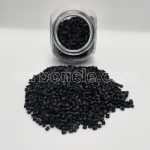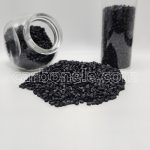
High Quality PA610 CF50 For Automotive Parts
PA610 CF50 composites combine polyamide 610 with 50% carbon fiber, offering high strength, stiffness, and heat resistance. They find applications in automotive components, aerospace parts, and industrial machinery where lightweight and durable materials are essential for performance and efficiency.
- Model: PA610-CF-BCA5
- Matrix resin: PA610 /Nylon 610 /Polyamide 610
- Formula: Carbon fibers, additives, etc.
- Color: Black
- OEM/ODM services: Acceptable
- Free samples: 1-5kgs
- Molding process: Injection/extrusion
What are PA610 50%Carbon Fiber composites?
PA610 CF50 composites are a type of material that combines polyamide 610 (PA610) with 50% carbon fiber reinforcement. This combination offers a unique set of features and benefits that make it suitable for various demanding applications across different industries.
Which features do PA610 CF50 composites present?
1. High Strength-to-Weight Ratio: The addition of 50% carbon fiber reinforcement significantly enhances the strength of PA610 CF50 composites while keeping their weight relatively low. This makes them ideal for applications where high strength and lightweight properties are critical.
2. Excellent Stiffness: Carbon fiber reinforcement also improves the stiffness of PA610, providing dimensional stability and resistance to deformation under load. This feature is particularly advantageous in structural applications.
3. Good Chemical Resistance: PA610 inherently offers good resistance to various chemicals, oils, and greases. The carbon fiber reinforcement further enhances this property, making PA610+CF50% composites suitable for environments where exposure to chemicals is a concern.
4. Thermal Stability: These composites exhibit good thermal stability, with a high melting point and resistance to heat distortion. This property ensures their performance across a wide range of temperatures, making them suitable for both high and low-temperature applications.
5. Low Moisture Absorption: Compared to other materials, PA610 CF50 composites have relatively low moisture absorption characteristics. This property is beneficial in applications where dimensional stability is crucial, even under varying environmental conditions.
6. Electrical Insulation Properties: PA610 CF50 composites offer good electrical insulation properties, making them suitable for applications where electrical conductivity needs to be minimized.
7. Design Flexibility: The manufacturing process of PA610 CF50 composites allows for flexibility in design. They can be molded into complex shapes, allowing engineers to optimize designs for specific application requirements.
Where can PA610 50%CF composites be used?
1. Automotive Industry:
PA610 CF50 composites find extensive use in the automotive sector, particularly in components that require high strength and lightweight properties. Applications include:
– Engine Components: Such as intake manifolds, valve covers, and oil pans.
– Structural Parts: Like brackets, housings, and under-the-hood components.
– Interior Components: Such as seat structures and panels.
2. Aerospace Industry:
Due to their high strength-to-weight ratio and excellent stiffness, PA610 CF50 composites are used in aerospace applications where performance under extreme conditions is crucial. Examples include:
– Interior Panels: For aircraft cabins and cargo areas.
– Structural Components: Such as brackets and housings for aircraft systems.
3. Industrial Equipment:
In various industrial equipment, PA610 CF50 composites are preferred for their durability and resistance to chemicals and oils. Typical applications include:
– Machine Parts: Such as gears, rollers, and bearings.
– Housings: For motors, pumps, and other machinery components.
4. Sporting Goods:
PA610 CF50 composites are used in the manufacture of high-performance sporting goods due to their lightweight nature and excellent strength characteristics. Applications include:
– Bicycle Components: Such as frames and handlebars.
– Sporting Equipment: Like tennis racquets, golf club shafts, and ski poles.
5. Electrical and Electronics:
In the electrical and electronics industry, PA610 CF50% composites are valued for their electrical insulation properties and resistance to heat. Typical applications include:
– Connectors and Housings: For electronic devices.
– Insulating Components: Such as circuit breakers and electrical enclosures.
6. Consumer Goods:
In consumer goods, PA610 CF50% composites are utilized for products that benefit from their lightweight and durable characteristics. Examples include:
– Luggage: Particularly for hard-shell suitcases and bags.
– Outdoor Equipment: Such as camping gear and backpack frames.
PA610 CF50 composites offer a compelling combination of high strength, stiffness, chemical resistance, and thermal stability.
These properties make them versatile across a wide range of industries, including automotive, aerospace, industrial equipment, sporting goods, electrical and electronics, and consumer goods.
As technology advances and manufacturing processes improve, the applications for PA610+CF50 composites are likely to expand further, driven by their performance advantages in demanding environments.
Content Block 1
Morbi iaculis at quam vel faucibus. Ut semper ipsum ex, quis aliquet justo pretium a. Suspendisse scelerisque metus augue, a interdum leo iaculis sed. Vivamus sit amet nunc odio. Duis vel pulvinar dolor, at lacinia tellus.
Pellentesque habitant morbi tristique senectus et netus et malesuada fames ac turpis egestas. Suspendisse lacinia quam a elit lobortis tempor


Content Block 1
Morbi iaculis at quam vel faucibus. Ut semper ipsum ex, quis aliquet justo pretium a. Suspendisse scelerisque metus augue, a interdum leo iaculis sed. Vivamus sit amet nunc odio. Duis vel pulvinar dolor, at lacinia tellus.
Pellentesque habitant morbi tristique senectus et netus et malesuada fames ac turpis egestas. Suspendisse lacinia quam a elit lobortis tempor

Frequently Asked Questions
Carbon (Xiamen) New Material Co., Ltd. aims to provide buyers with "one-stop" worry-free high-quality services. Here you can find all information about carbon fiber engineering plastics. If you still have questions, please send us an email for consultation!
-
How can I contact the manufacturer of a product that interests me?
When you find a product you are interested in, you can contact the manufacturer directly by sending an email and we will get back to you as soon as possible.
-
How do I find the products that interest me?
All you need to do is enter the keyword, product name in the search window and press the Enter key on your keyboard. Your search results page will then be displayed. You can also search within the product category pages on the home page. Each category is divided into subcategories, allowing you to refine your search and find products that interest you.
-
Where will I find a buying guide?
Please contact our after-sales service directly and we will provide you with a comprehensive operating guide.
-
What are CF Reinforced Thermoplastic Composites?
CF Reinforced Thermoplastic Composites are materials where carbon fibers are incorporated into a thermoplastic matrix. They combine the strength and stiffness of carbon fibers with the processability and recyclability of thermoplastics. For instance, they are used in automotive parts like bumper beams.
-
What are the benefits of CF Reinforced Thermoplastic Composites over traditional composites?
The key benefits include faster production cycles, easier recyclability, and better impact resistance. They also offer design flexibility. An example is in the manufacturing of consumer electronics casings where complex shapes can be achieved more easily.
-
How are CF Reinforced Thermoplastic Composites processed?
Common processing methods include injection molding, extrusion, and compression molding. Injection molding is widely used for mass production. For example, in the production of small components for the medical industry.
-
What industries use CF Reinforced Thermoplastic Composites?
They are utilized in aerospace, automotive, medical, and sports equipment industries. In aerospace, they can be found in interior components. In the medical field, they might be used in prosthetics.
-
How does the carbon fiber content affect the properties of the composites?
Higher carbon fiber content generally leads to increased strength and stiffness but may reduce ductility. A moderate content is often balanced for specific applications. For example, a higher content might be preferred in structural parts of a race car.
-
What are the challenges in using CF Reinforced Thermoplastic Composites?
Challenges include higher material costs, complex processing equipment requirements, and ensuring uniform fiber dispersion. Issues with adhesion between the fibers and the matrix can also arise. An example is in achieving consistent quality in large-scale production.























